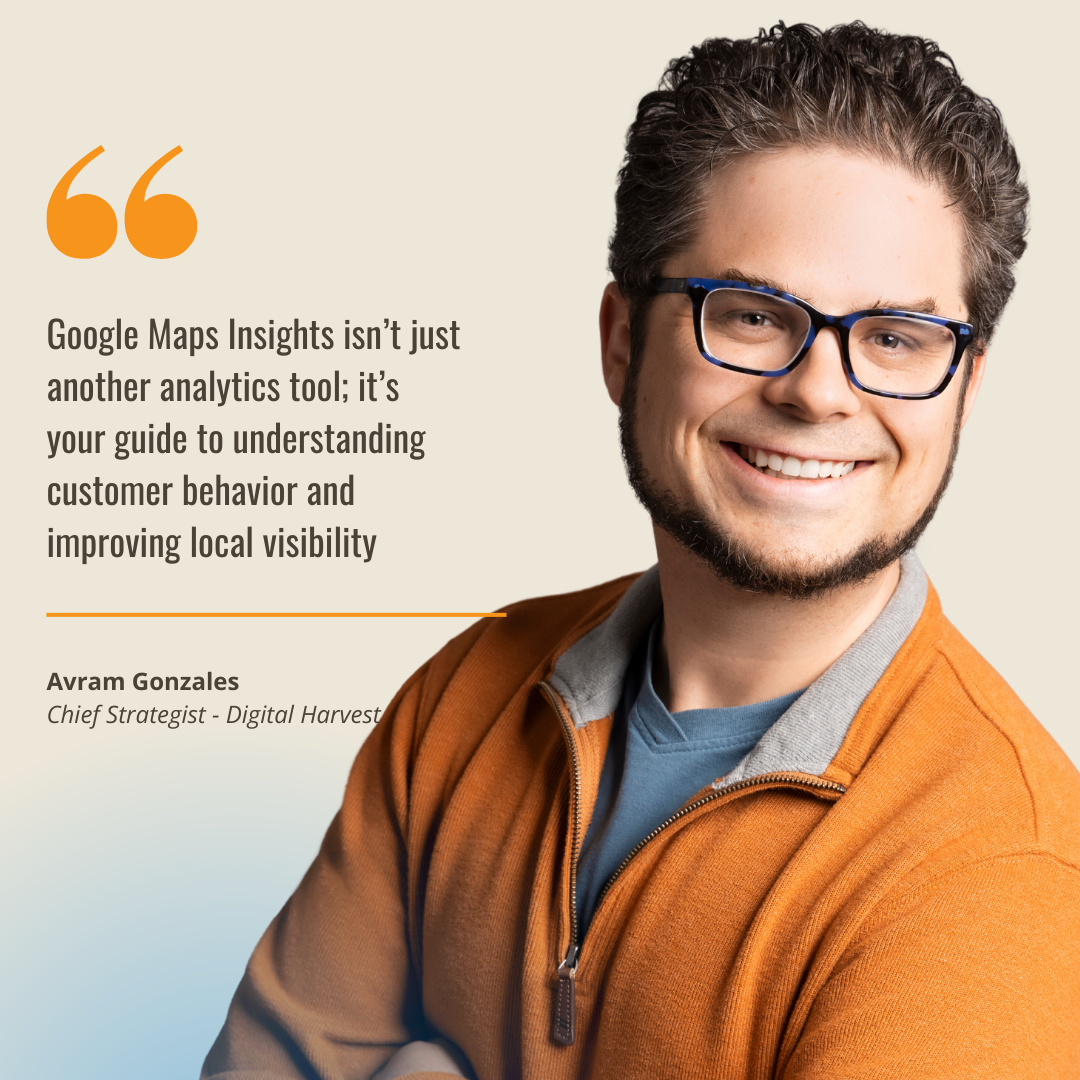How to Use Google Maps Insights to Improve Your Local Reach
46% of all Google searches are seeking local information. Are you showing up in the right place? For local businesses, especially home service providers, being found easily by nearby customers is critical.
Google Maps Insights helps connect the dots between your online presence and your potential customers by offering valuable data on how people find and interact with your business.
This guide will take you through everything you need to know about Google Maps Insights, explaining its key features and how you can leverage the data to improve your local reach. From defining core metrics to creating strategies, this post is your roadmap to attracting more customers and growing your community presence.
What Are Google Maps Insights?
Google Maps Insights is a tool within your Google Business Profile (GBP) dashboard that provides valuable analytics about how customers interact with your business online. It tracks essential metrics such as search queries, customer engagement, and popular service times, giving you detailed insights into how your listing performs.

Key Metrics Tracked by Google Maps Insights
- Search Types (Direct vs. Discovery): Tracks how customers find your business—whether they search for you directly or discover you while searching for a service.
- Customer Actions (Calls, Clicks, Direction Requests): Provides data on how users engage with your listing.
- Views (Search vs. Maps): Measures how often your business is seen on Google Search versus Google Maps.
- Popular Times & Photos: Highlights when your business gets noticeable activity and which photos resonate most with your audience.
Why It Matters
“Google Maps Insights isn’t just another analytics tool; it’s your guide to understanding customer behavior and improving local visibility,” says Avram Gonzales, Chief Strategist of Digital Harvest. It doesn’t just report numbers. It helps identify strengths, weaknesses, and opportunities, so you can refine your approach for maximum visibility.
Key Performance Metrics: A Detailed Overview
To truly leverage Google Maps Insights, you first need to understand its core metrics and their value. These are the following:
Search Queries: What Are Customers Searching For?
Google Maps Insights shows you the exact keywords and phrases that led people to your business. By identifying frequent search terms, you can optimize your listing’s description, add relevant keywords to your website, and align your services with customer expectations.
Example:
A roofing company notices that "emergency roof repair" is a top search query. They optimize their GBP description and website copy to highlight this service, leading to more traffic and emergency job bookings.
Customer Interactions: Measuring Engagement
This metric includes the total number of actions taken on your listing, such as:
- Calls
- Clicks to your website
- Requests for directions
It gives you actionable insights into your profile's effectiveness. If direction requests or calls spike, that likely means your listing is drawing in prospective customers.
Example:
A plumbing business noticed customers struggled to find their location despite many direction requests, causing delays and frustration. To fix this, they updated their online profile with clear parking instructions and detailed location info, like landmarks and entrance directions.
This simple change made it easier for clients to find them, boosting customer satisfaction and improving operations.
Views on Maps vs. Search
It shows how often users find your business through Google Search versus Google Maps, giving you insight into how customers discover you online.
If most views come from Google Search, it suggests your website's SEO is working well. If more views come from Google Maps, it shows your local SEO efforts, like optimizing your Google Business Profile, are paying off.
Knowing where you're more visible helps you focus on improving your local presence, refining keywords, or updating business details to attract more traffic through the right channels.
Example:
A pest control service notices most of its traffic comes from Google Maps. To boost credibility and visibility further, they decide to upload geo-tagged images of their team in action.
Advanced Strategies for Leveraging Google Maps Insights

Once you understand the metrics, the next step is using the data to craft impactful strategies that maximize your local reach.
1. Combine Insights with Local SEO
Search queries from Google Maps Insights provide valuable data about how users search for businesses in your area. Analyzing this information can help you better understand customer behavior and refine your local SEO strategy to improve visibility and attract more local traffic.
Here are some actionable tips to improve your online visibility:
- Use high-performing keywords to update your website and Google Business Profile (GBP) description. Research trending keywords in your industry and incorporate them naturally into your content to improve visibility and attract the right audience.
- Optimize your service area details based on the most searched locations. Analyze search trends to identify where your services are most in demand and adjust your service area settings accordingly to reach potential customers more effectively.
Example:
A home cleaning service notices high interest in "deep cleaning services in [specific neighborhood]." As a result, they create a service page targeting that area, which improves both web search rankings and local engagement.
2. Tailor Marketing Campaigns Based on Customer Actions
Leverage customer behavior data to gain deeper insights into your audience and plan smarter, more targeted marketing campaigns that drive better results. By understanding how customers interact with your brand, you can create strategies that truly resonate with their needs and preferences.
Here are some actionable steps you can take to maximize your results and improve performance:
- Analyze the data to identify high-performing areas, such as locations or times that generate the most direction requests or calls, and allocate additional ad budget to these areas for better returns.
- Develop and launch targeted promotions at specific times or locations where peak activity occurs, ensuring your campaigns reach the right audience at the right moment.
Example:
An HVAC company notices that most calls come during the spring, so they create a seasonal ad campaign promoting tune-ups and repairs, which helps boost sales during peak demand periods.
3. Monitor Competitor Trends with Indirect Insights
Using tools like BrightLocal to monitor competitors provides valuable contextual information to refine your approach. By analyzing their strategies, such as local SEO performance, customer reviews, and online rankings, you can identify areas for improvement and uncover opportunities to stay ahead in your market.
To stay ahead in the competitive landscape, it’s important to take a strategic approach to analyzing your performance. Here’s what to do:
- Start by comparing your listing's performance with that of your competitors. Look closely at areas where they may outperform you to identify potential gaps in your strategy.
- Take advantage of their weaknesses by turning them into opportunities. Use this insight to enhance your content, improve your services, or offer something unique that sets you apart.
Example:
After noticing that competitors' top queries focus on emergency services, a landscaping company decided to add "24/7 availability" to their GBP description. As a result, they saw an increase in visibility and traffic.
4. Leverage Insights to Enhance Your GBP Features
Insights can inspire creative and strategic ways to keep your profile better tailored to customer needs by highlighting trends in customer behavior, identifying popular services or products, and showing which aspects of your profile generate the most engagement.
To maximize your platform's features and keep your audience engaged, follow these steps:
- Regularly update your photo gallery by analyzing which images or categories customers interact with the most. This keeps your visuals fresh, relevant, and aligned with your audience's preferences.
- Consistently create and share updates, blogs, or promotional content that incorporates trending keywords. This not only keeps your content current but also improves visibility and engagement by aligning with popular topics your audience is searching for.
Example:
A landscaping company experiences high interest in seasonal work through customer interactions. By uploading freshly completed seasonal photos to its profile, the company notices an increase in engagement.
Your Roadmap to Mastering Google Maps Insights

Google Maps Insights isn’t just about numbers—it’s about creating strategies that resonate with your customers. By effectively analyzing search queries, customer interactions, and visibility metrics, you can identify actionable opportunities to improve your local reach and dominate your market.
Steps to Start Today:
- Refine your keywords in your GBP and website descriptions.
- Use insights to run data-driven marketing strategies.
- Regularly update and optimize your Google Business Profile.
Want expert guidance tailored to your unique business needs? Explore the Digital Harvest website or connect with Avram Gonzales on LinkedIn for more strategies to help grow your business.
